Antifungal mechanisms by which a novel Pseudomonas aeruginosa phenazine toxin kills Candida albicans in biofilms
- PMID: 21143312
- PMCID: PMC3828654
- DOI: 10.1111/j.1365-2958.2010.07414.x
Antifungal mechanisms by which a novel Pseudomonas aeruginosa phenazine toxin kills Candida albicans in biofilms
Abstract
Pseudomonas aeruginosa produces several phenazines including the recently described 5-methyl-phenazine-1-carboxylic acid (5MPCA), which exhibits a novel antibiotic activity towards pathogenic fungi such as Candida albicans. Here we characterize the unique antifungal mechanisms of 5MPCA using its analogue phenazine methosulphate (PMS). Like 5MPCA, PMS induced fungal red pigmentation and killing. Mass spectrometry analyses demonstrated that PMS can be covalently modified by amino acids, a process that yields red derivatives. Furthermore, soluble proteins from C. albicans grown with either PMS or P. aeruginosa were also red and demonstrated absorbance and fluorescence spectra similar to that of PMS covalently linked to either amino acids or proteins in vitro, suggesting that 5MPCA modification by protein amine groups occurs in vivo. The red-pigmented C. albicans soluble proteins were reduced by NADH and spontaneously oxidized by oxygen, a reaction that likely generates reactive oxygen species (ROS). Additional evidence indicated that ROS generation precedes 5MPCA-induced fungal death. Reducing conditions greatly enhanced PMS uptake by C. albicans and killing. Since 5MPCA was more toxic than other phenazines that are not modified, such as pyocyanin, we propose that the covalent binding of 5MPCA promotes its accumulation in target cells and contributes to its antifungal activity in mixed-species biofilms.
© 2010 Blackwell Publishing Ltd.
Figures
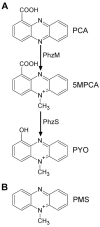


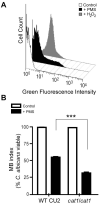
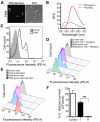
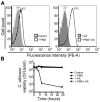
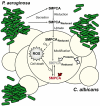
Similar articles
-
Pseudomonas aeruginosa-Candida albicans interactions: localization and fungal toxicity of a phenazine derivative.Appl Environ Microbiol. 2009 Jan;75(2):504-13. doi: 10.1128/AEM.01037-08. Epub 2008 Nov 14. Appl Environ Microbiol. 2009. PMID: 19011064 Free PMC article.
-
Control of Candida albicans metabolism and biofilm formation by Pseudomonas aeruginosa phenazines.mBio. 2013 Jan 29;4(1):e00526-12. doi: 10.1128/mBio.00526-12. mBio. 2013. PMID: 23362320 Free PMC article.
-
Conditional antagonism in co-cultures of Pseudomonas aeruginosa and Candida albicans: An intersection of ethanol and phosphate signaling distilled from dual-seq transcriptomics.PLoS Genet. 2020 Aug 19;16(8):e1008783. doi: 10.1371/journal.pgen.1008783. eCollection 2020 Aug. PLoS Genet. 2020. PMID: 32813693 Free PMC article.
-
Polymicrobial Ventilator-Associated Pneumonia: Fighting In Vitro Candida albicans-Pseudomonas aeruginosa Biofilms with Antifungal-Antibacterial Combination Therapy.PLoS One. 2017 Jan 23;12(1):e0170433. doi: 10.1371/journal.pone.0170433. eCollection 2017. PLoS One. 2017. PMID: 28114348 Free PMC article.
-
Antifungal susceptibility of Candida albicans in biofilms.Mycoses. 2012 May;55(3):199-204. doi: 10.1111/j.1439-0507.2011.02076.x. Epub 2011 Jul 28. Mycoses. 2012. PMID: 21793943 Review.
Cited by
-
The Effect of Phenazine-1-Carboxylic Acid on the Morphological, Physiological, and Molecular Characteristics of Phellinus noxius.Molecules. 2016 May 11;21(5):613. doi: 10.3390/molecules21050613. Molecules. 2016. PMID: 27187325 Free PMC article.
-
A balancing act: investigations on the impact of altered signal sensitivity in bacterial quorum sensing.J Bacteriol. 2023 Dec 19;205(12):e0024923. doi: 10.1128/jb.00249-23. Epub 2023 Nov 27. J Bacteriol. 2023. PMID: 38009926 Free PMC article.
-
Cross-Domain and Viral Interactions in the Microbiome.Microbiol Mol Biol Rev. 2019 Jan 9;83(1):e00044-18. doi: 10.1128/MMBR.00044-18. Print 2019 Mar. Microbiol Mol Biol Rev. 2019. PMID: 30626617 Free PMC article. Review.
-
Effect of Producing Different Phenazines on Bacterial Fitness and Biological Control in Pseudomonas chlororaphis 30-84.Plant Pathol J. 2018 Feb;34(1):44-58. doi: 10.5423/PPJ.FT.12.2017.0277. Epub 2018 Feb 1. Plant Pathol J. 2018. PMID: 29422787 Free PMC article.
-
Mobilization of Iron Stored in Bacterioferritin Is Required for Metabolic Homeostasis in Pseudomonas aeruginosa.Pathogens. 2020 Nov 24;9(12):980. doi: 10.3390/pathogens9120980. Pathogens. 2020. PMID: 33255203 Free PMC article.
References
-
- Anjaiah V, Koedam N, Nowrk-Thompson B, Loper J, Höfte M, Tambong J, Cornelis P. Involvement of phenazines and anthranilate in the antagonism of Pseudomonas aeruginosa PNA1 and Tn5 derivatives Toward Fusarium spp. and Pythium spp. Molecular Plant-Microbe interactions. 1998;11:847–854.
-
- Barelle CJ, Manson CL, MacCallum DM, Odds FC, Gow NA, Brown AJ. GFP as a quantitative reporter of gene regulation in Candida albicans. Yeast. 2004;21:333–340. - PubMed
-
- Bauernfeind A, Bertele RM, Harms K, Horl G, Jungwirth R, Petermuller C, Przyklenk B, Weisslein-Pfister C. Qualitative and quantitative microbiological analysis of sputa of 102 patients with cystic fibrosis. Infection. 1987;15:270–277. - PubMed
-
- Bisschop A, Bergsma J, Konings WN. Site of interaction between phenazine methosulphate and the respiratory chain of Bacillus subtilis. Eur J Biochem. 1979;93:369–374. - PubMed

